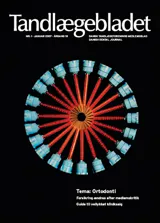Tidig ortodontisk behandling i Finland – varför, när och hur?
Både ortodontiska behandlingsrutiner och tidsschema för behandling varierar i de nordiska länderna. I Finland är en tidigt påbörjad ortodontisk behandling vanligare. Anledning till detta kan vara att forskningens tyngdpunkt traditionellt är relaterad till tillväxt och utveckling. Bristen på specialisttandläkare har också medfört ett behov att utveckla enkla behandlingsmodeller, som tandläkare med baskunskaper i ortodonti kan genomföra under handledning av specialist. Artikeln presenterar de vanligaste behandlingsalternativen, som används inom den tidiga behandlingen i Finland såsom extraoralt drag (EOD) nackdrag, quad helix och bitningsgejd. Korsbett och bett med Angle klass II (postnormalt bett) kan behandlas med dessa typer av apparatur. Facemask, som används för behandling av prenormala bett (Angle klass III) används mera sällan. Syftet med tidig behandling är att minska behovet av ortodontisk behandling längre fram och att försöka reducera omfattningen av eventuell senare ortodontisk behandling.
Early orthodontic treatment in Finland – why, when and how? Orthodontic treatment methods and appliances vary to some degree in the Nordic countries. Orthodontists in Finland favour early treatment and frequently use appliances that work well in the deciduous and early mixed dentition. This seems to be related to the orthodontic research tradition in Finland which places emphasis on the growth and development of the craniofacial complex. A need for simple orthodontic treatment techniques, manageable by general dentists who have a central role in the delivery of treatment, also direct the focus on interception and early treatment. In early treatment, the diagnosis of unfavourable occlusal or skeletal development is largely based on the deciduous occlusion. It is therefore crucial that not only orthodontists but also the dentists and auxiliary personnel have a proper knowledge of normal occlusion and are able to detect signs of abnormal development. The orthodontic appliances that are most frequently used in the deciduous and early mixed dentition, include head gear, quad helix and eruption guidance appliance. Finnish studies have shown that head gear is an effective tool in Class II correction. In transversal problems, the quad helix gives good treatment results if used early. The eruption guidance appliance works efficiently, both as an interceptive and a corrective tool in the early treatment of Class II malocclusion, excess overjet, deep bite and crowd -ing. Furthermore, the anterior face mask has been found to be effective in the early treatment of Class III patients. Finnish orthodontists and dentists have obtained good results with early orthodontic treatment. Clinical experience shows that it has been possible to reduce further need of treatment, simplify later treatment phases, and to expand the coverage of treatment.


